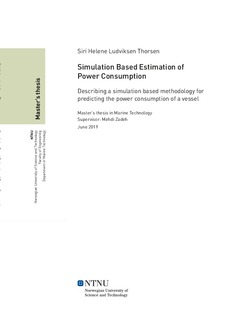| dc.contributor.advisor | Zadeh, Mehdi | |
| dc.contributor.author | Thorsen, Siri Helene Ludviksen | |
| dc.date.accessioned | 2019-10-26T14:05:05Z | |
| dc.date.available | 2019-10-26T14:05:05Z | |
| dc.date.issued | 2019 | |
| dc.identifier.uri | http://hdl.handle.net/11250/2624702 | |
| dc.description.abstract | De siste årene har den maritime industrien fått en betydelig interesse for å redusere drivhusgass utslippene fra næringen. Strenge krav som har trådt i kraft har ført til at skipsbyggere har blitt tvunget til å handle raskt for å finne grønne løsninger på skipsdesignet. I lys av å finne innovasjoner som møter de nye reguleringene, har nødvendigheten av å forbedre de tradisjonelle designmetodene fanget interesse blant skipsbyggerne. Simulering og virituell testing har blitt et viktig aspekt for utviklingen av metodene brukt innenfor skipsbygging. Dette muliggjør å kunne evaluere skipsmodellen under mer realistiske operasjonsforhold, enn den tradisjonelle metoden som kun forholder seg til ideelle forbehold.
Metoden som er presentert i denne oppgaven benytter simulering for å estimere effektforbruket for et lasteskip. Tilnærmingen baserer seg på den empiriske metoden Hollenbach for å beregne motstand i rolig sjø, og Wageningen-B skruserie for å estimere propellvirkningsgraden. I tillegg brukes værdata for å predikere bølgemotstand ved bruk av STAWAVE-1 metoden, gitt lokasjon og tid fra GPS-data til skipet. Fordelen med å bruke GPS-data er at det er lett tilgjengelig, i motsetning til historisk data for effektforbruket. Metoden er beskrevet i detalj, og inkluderer metoder og antagelser som ligger til grunn. Metoden er programmert i MatLab, med tilhørende instruksjoner om hvordan metoden skal implementeres.
Resultatene viser at det finnes et stort potensial med å bruke simulering basert på empiriske metoder og bruk av GPS-data til å kalkulere bølgemotstand. Metoden klarer å få frem innvirkningen motstanden i rolig sjø og propellvirkningsgraden har på det totale effektforbruket. Det er derimot nødvendig å utvikle en dypere forståelse for antagelsene bak reelle operasjonsforhold for å gjøre modellen mer presis. Bølgemotstanden kan fordelaktig bli mer nøyaktig ved å innføre flere reelle antagelser til modellen. Effekten som utgjøres ved lave forbruk, blir ofte neglisjert i simuleringen, hvilket gir et upresist bilde av det totale forbruket. Det må til gjengjeld påpekes at metoden fortsatt er i stand til å implementere informasjon tidlig i designprosessen, og lar brukeren estimere ytelsen til skipet uten en iterativ "prøv-og-feil" metode. | |
| dc.description.abstract | During the last years have the maritime industry taken a significant interest in reducing their greenhouse gas emissions related to shipping. Strict emission regulations have taken effect and forced the ship designers to take immediate action for finding low-emission solutions for vessel design. In light of finding innovations that meets the new regulations, the urgency of improving the traditional design methods have sparked an interest among ship designers. Simulation and virtual testing has become important for the research of better design methodologies. This introduce a more accurate evaluation of the vessel model that includes more realistic operational conditions than the traditional methodology, which is limited to idealized conditions.
The methodology presented in this thesis uses simulation for estimating the power consumption of a general cargo vessel. The approach is based on the empirical method Hollenbach for resistance in calm water, and Wagnening-B screw series for estimating the open water efficiency. In addition will weather data be used for estimating resistance due to waves with the method STAWAVE-1, utilizing the location and time for the vessel in the GPS-data. Power consumption isn't necessarily available for the masses, unlike GPS-data which is easily assessed. The methodology is described in detail, including underlying methods and assumptions used. The method is programmed in MatLab with instructions on how to use it. %Finding a methodology that gives accurate results will open up for predicting consumption of innovative power systems and configurations.
The results shows that there exist a great potential of using a simulation approach that is based on empirical methods and GPS-data for weather implementation. The methodology captures the impact of how calm water resistance and propeller efficiency affects the overall performance. On the other hand, there's still need for a deeper understanding of the underlying assumptions, to be able to create a precise model for real life operation. The resistance due to weather can profitably cover more aspects of the real life operation to estimate a more accurate prediction. The consumption at lower loading's is often neglected in the simulation, which give an imprecise visualization of the overall consumption. It should however be pointed out that the methodology still captures the advantage of implementing new information in the preliminary design stage, and allows the user to investigate the vessel performance without an iterative "try-and-error" approach. | |
| dc.language | eng | |
| dc.publisher | NTNU | |
| dc.title | Simulation Based Estimation of Power Consumption | |
| dc.type | Master thesis | |
